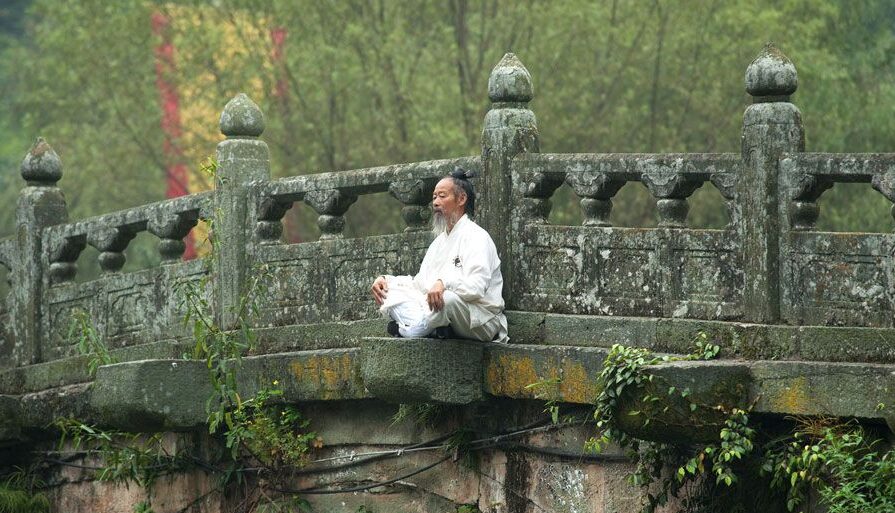Step-by-Step Guide to Taoist Meditation Practice for Beginners

Are you a beginner looking to explore the ancient practice of Taoist meditation? This step-by-step guide is here to help you on your journey.
Discover the history and benefits of Taoist meditation, as well as the techniques used to cultivate mindfulness and stillness.
Learn how to create the perfect environment for your practice and explore the power of Taoist visualization.
Get ready to embark on a transformative journey of self-discovery and inner peace.
Key Takeaways
- Taoist meditation originated in ancient China and is a practice that cultivates the body, mind, and spirit.
- Taoist meditation practices have evolved over time and have been influenced by Taoist principles, incorporating techniques such as visualization and movement-based practices like Tai Chi and Qi Gong.
- Taoist meditation offers a range of benefits, including enhanced mental clarity, improved emotional well-being and reduced stress, deepened spiritual awareness and connection, and the cultivation of a calm and focused mind.
- The practice of Taoist meditation can have far-reaching cognitive benefits, helping individuals think more clearly, make better decisions, and carry over the benefits into other aspects of life.
The History of Taoist Meditation
Taoist meditation has a rich history that dates back thousands of years. The origins of Taoist meditation can be traced back to ancient China, where it was developed as a way to cultivate the body, mind, and spirit.
Throughout history, Taoist meditation practices have evolved and adapted to different cultural and philosophical influences. These practices have been influenced by Taoist principles such as simplicity, harmony, and balance.
Taoist meditation has been used by individuals to achieve spiritual enlightenment, increase vitality, and improve overall well-being. Over the years, various techniques and methods have been developed, including visualization, breathing exercises, and movement-based practices like Tai Chi and Qi Gong.
Today, Taoist meditation continues to be practiced by people all over the world, seeking inner peace and self-discovery.
Benefits of Taoist Meditation Practice
If you’re looking to enhance your mental clarity, improve your emotional well-being, and increase your spiritual awareness, Taoist meditation practice might be just what you need.
Through the practice of Taoist meditation, you can cultivate a calm and focused mind, allowing you to think more clearly and make better decisions.
Additionally, this ancient practice can help you connect with your emotions on a deeper level, leading to a greater sense of peace and contentment.
And as you continue to delve into Taoist meditation, you may find that it opens up new realms of spiritual awareness, helping you connect with a higher power and gain a deeper understanding of yourself and the world around you.
Enhanced Mental Clarity
To achieve enhanced mental clarity, it’s important to create a quiet and peaceful environment for your meditation practice. By eliminating distractions and finding a calm space, you can fully immerse yourself in the practice and reap the benefits.
Taoist meditation can help you enhance your focus and improve cognitive function. As you sit in silence, allowing your mind to quiet down, you create space for clarity to emerge. The practice of focusing on your breath or a specific mantra helps to train your mind and increase concentration.
This enhanced focus carries over into other aspects of your life, allowing you to approach tasks with a clear and sharp mind. The cognitive benefits of Taoist meditation are far-reaching, helping you think more clearly and make better decisions in your daily life.
Improved Emotional Well-Being
When you cultivate a regular meditation practice, you can experience a significant improvement in your emotional well-being. By connecting your mind and body through meditation, you can reduce stress and enhance your overall emotional state.
Through the practice of meditation, you learn to calm your mind and focus on the present moment, allowing you to let go of worries and anxieties. This mind-body connection helps to release tension and promotes a sense of relaxation and inner peace.
As you continue to meditate regularly, you may notice that your emotional responses become more balanced and stable. Meditation also provides a safe space for you to explore and process your emotions, allowing you to gain a deeper understanding of yourself and cultivate greater self-compassion.
Increased Spiritual Awareness
By connecting with your inner self through meditation, you can deepen your spiritual awareness and develop a stronger sense of connection to the world around you. Taoist meditation techniques can help you achieve this deepening of your spiritual connection. These techniques focus on cultivating a state of deep relaxation, inner stillness, and harmonious energy flow. Through the practice of Taoist meditation, you can tap into your inner wisdom and align yourself with the natural flow of the universe. This can lead to a heightened sense of spiritual awareness and a greater understanding of your place in the world. Here is a table highlighting three Taoist meditation techniques that can assist you in deepening your spiritual connection:
| Technique | Description | Benefits |
|---|---|---|
| Microcosmic Orbit | Circulating energy along the body’s energy channels | Balances energy, enhances vitality |
| Inner Smile Meditation | Smiling inwardly to cultivate positive emotions and harmonize energy | Promotes emotional well-being, increases self-compassion |
| Six Healing Sounds | Vocalizing specific sounds to release negative emotions and harmonize energy flow | Clears emotional blockages, promotes overall well-being |
Understanding Taoist Breathwork Techniques
Take a moment to fully relax and focus on your breath. Taoist breathwork techniques can greatly enhance your meditation practice.
Taoist breathwork techniques involve deep, slow breaths that help to calm the mind and cultivate energy within the body. By consciously regulating your breath, you can bring more oxygen into your system, which increases alertness and clarity during meditation. These techniques also help to balance your energy and promote a sense of harmony within yourself.
By integrating Taoist breathwork into your meditation practice, you can experience numerous benefits. These include improved focus, reduced stress, increased relaxation, and enhanced spiritual connection.
As you continue to practice Taoist breathwork techniques, you will find that your meditation becomes deeper and more fulfilling, allowing you to tap into the profound wisdom of the Tao.
Step 1: Setting the Right Environment for Meditation
When it comes to creating the right environment for meditation, there are a few key points to keep in mind.
First, focus on lighting and ambiance. Make sure the room is well-lit, but not too bright, and consider using candles or soft lighting to create a calming atmosphere.
Second, choose comfortable seating that supports your body and allows you to relax fully. Whether it’s a cushion on the floor or a comfortable chair, find a position that works for you.
Lastly, eliminate distractions. Turn off your phone, close the door, and create a quiet space where you can fully immerse yourself in your meditation practice.
Lighting and Ambiance
To create a soothing environment for your meditation practice, dim the lights and set a calm ambiance. The right lighting options can make a significant difference in creating a serene atmosphere that promotes relaxation and focus.
Consider the following options:
- Candles: The gentle flicker of candlelight can create a warm and cozy atmosphere, helping you to unwind and enter a meditative state.
- Salt lamps: These unique lamps emit a soft, warm glow that not only adds to the ambience but also releases negative ions, promoting a sense of calm and well-being.
- String lights: Delicate fairy lights can create a magical and tranquil space, filling it with a soft and subtle glow that is perfect for meditation.
Experiment with different lighting options to find what works best for you and enhances your meditation practice. Remember, the goal is to create a peaceful and serene environment that supports your journey inward.
Choosing Comfortable Seating
Now that you have set the perfect ambiance for your Taoist meditation practice, let’s focus on choosing comfortable seating. Finding the right cushion is crucial for maintaining proper posture and achieving a deep state of relaxation.
To help you visualize the options available, here is a table comparing different types of cushions:
| Cushion Type | Material | Benefits |
|---|---|---|
| Zafu | Buckwheat hulls | Provides firm support for the hips and spine |
| Meditation Bench | Wood | Promotes an open posture and relieves pressure on the lower back |
| Yoga Bolster | Cotton or foam | Offers versatile support for various seated positions |
Eliminating Distractions
Distractions can hinder your ability to achieve a deep state of relaxation during meditation. To minimize interruptions and find inner calm, here are a few tips to consider:
- Create a quiet space: Find a location where you can be free from external noises and disturbances. This could be a dedicated room, a corner in your house, or even a peaceful outdoor spot.
- Turn off electronic devices: Switch off your phone, computer, or any other devices that might distract you with notifications or alerts. Disconnecting from technology will help you focus solely on your meditation practice.
- Set boundaries: Communicate with those around you, letting them know that you need uninterrupted time to meditate. Ask them to respect your space and refrain from interrupting you during this time.
Step 2: Cultivating Mindfulness and Stillness
Focus on your breath and let go of any thoughts or worries that arise. In this step of Taoist meditation, you will be cultivating mindfulness and stillness. This practice helps to cultivate focus and deepens relaxation. Find a quiet and comfortable place to sit, preferably with your back straight and supported. Close your eyes and take a few deep breaths, allowing your body to relax with each exhale. Now, bring your attention to your breath, noticing the sensation of each inhale and exhale. As thoughts or distractions arise, simply acknowledge them without judgment and gently return your focus to your breath. This process of cultivating mindfulness and stillness builds a foundation for deeper states of meditation.
| Cultivating Mindfulness and Stillness |
|---|
| Focus on your breath |
| Let go of thoughts and worries |
| Cultivate mindfulness |
| Deepen relaxation |
| Return focus to breath |
Step 3: Exploring Taoist Visualization Techniques
In this next phase, we’ll explore Taoist visualization techniques to deepen your meditation practice. By incorporating these techniques, you can enhance your ability to focus and achieve a greater sense of inner peace and tranquility.
Here are three ways Taoist visualization techniques can benefit your meditation practice:
- Enhanced concentration: Visualizing specific images or scenes can help you maintain focus and prevent your mind from wandering during meditation.
- Deeper relaxation: By visualizing calming and serene landscapes, you can induce a state of deep relaxation, allowing you to release tension and stress.
- Increased energy flow: Through visualization, you can direct your energy to flow smoothly throughout your body, promoting overall well-being and vitality.
Frequently Asked Questions
What Is the Significance of the Lotus Position in Taoist Meditation Practice?
The lotus position is significant in Taoist meditation practice because it helps create a stable and grounded posture. Sitting cross-legged improves concentration, enhances energy flow, and promotes a sense of calm and tranquility.
Are There Any Dietary Guidelines or Restrictions to Follow While Practicing Taoist Meditation?
While practicing Taoist meditation, it is recommended to follow certain dietary guidelines and restrictions. These may include avoiding heavy or processed foods, and focusing on consuming light, natural, and balanced meals to support your practice.
How Can Taoist Meditation Help in Managing Stress and Anxiety?
Taoist meditation techniques can help you manage stress and anxiety. By focusing on your breath and emptying your mind, you can find inner peace and calm. The benefits of Taoist meditation include improved mental clarity and emotional well-being.
Is It Necessary to Have Prior Knowledge of Taoism to Practice Taoist Meditation?
No, prior knowledge of Taoism is not necessary to practice Taoist meditation. Anyone can engage in this meditation practice regardless of their background or beliefs. Simply focus on the present moment and your breath.
Can Taoist Meditation Be Practiced by People of All Ages and Physical Abilities?
Taoist meditation can be practiced by people of all ages and physical abilities. There are no age restrictions or physical limitations. It is a practice that anyone can engage in to cultivate inner peace and harmony.









